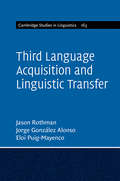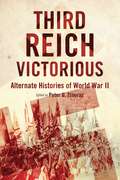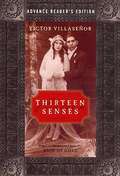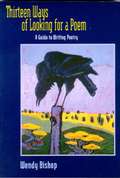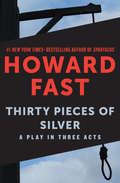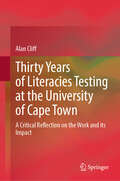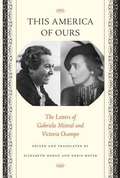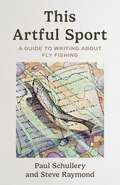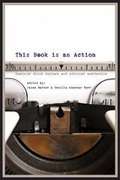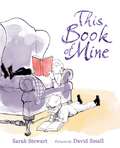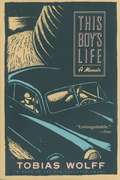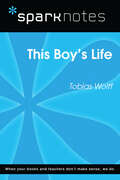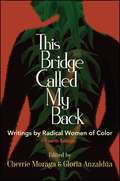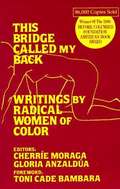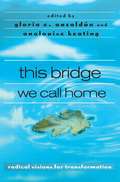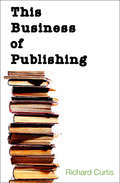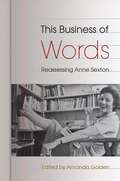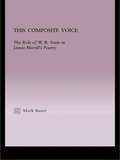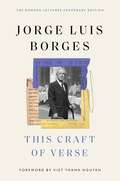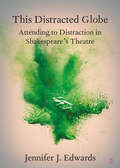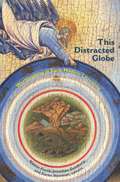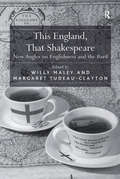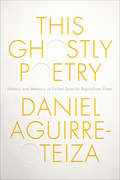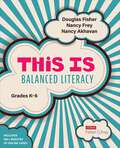- Table View
- List View
Third Language Acquisition and Linguistic Transfer (Cambridge Studies in Linguistics #163)
by Jason Rothman Jorge González Alonso Eloi Puig-MayencoIs acquiring a third language the same as acquiring a second? Are all instances of non-native language acquisition simply one and the same? In this first book-length study of the topic, the authors systematically walk the reader through the evidence to answer these questions. They suggest that acquiring an additional language in bilinguals (of all types) is unique, and reveals things about the links between language and mind, brain, and cognition, which are otherwise impossible to appreciate. The patterns of linguistic transfer and what motivates it when there are choices (as can only be seen starting in third language acquisition) underscores a key concept in linguistic and psychological sciences: economy. Overviewing the subfields examining multilingual acquisition and processing, this book offers an expanded systematic review of the field of multilingual morphosyntactic transfer, as well as providing recommendations for the future emerging field.
Third Reich Victorious: Alternate Histories of World War II
by Peter G. Tsouras<P> This book is a stimulating and entirely plausible insight into how Hitler and his generals might have defeated the Allies, and a convincing sideways look at the Third Reich's bid at world domination in World War II. <P> What would have happened if, for example, the Germans captured the whole of the BEF at Dunkirk? Or if the RAF had been defeated in the Battle of Britain? What if the U-Boats had strangled Britain with an impregnable blockade, if Rommel had been triumphant in North Africa or the Germans had beaten the Red Army at Kursk? The authors, writing as if these and other world-changing events had really happened, project realistic scenarios based on the true capabilities and circumstances of the opposing forces. Third Reich Victorious is a dynamic and eye-opening alternate history that opens up the dramatic possibilities of World War II.
Thirteen Senses: a Memoir
by Victor Edmundo VillaseñorThirteen Senses continues the exhilarating family saga that began in the widely acclaimed bestseller "Rain of Gold. Thirteen Senses begins with the fiftieth wedding anniversary of the aging former bootlegger Salvador and his elegant wife, Lupe. When asked by a young priest to repeat the sacred ceremonial phrase "to honor and obey," Lupe surprises herself and says. "No, I will not say 'obey.' How dare you! You don't talk to me like this after fifty years of marriage and I now knowing what I know!" After the hilarious shock of Lupe's rejection of the ceremony, the Villasenor family is forced to examine the love that Lupe and Salvador have shared for so many years -- a universal, gut-honest love that will eventually energize and inspire the couple into old age. In "Thirteen Senses, Victor Villasenor brings readers into the Bonnie-and-Clyde-like world of his colorful, immigrant family: a world set in Depression-era Southern California: a harsh world, where only the wily and strong survive, and where love, passion, and commitment to "familia are the sole dependable forces in Lupe's and Salvador's lives. In the unfolding of their story, we see Lupe move beyond her young and naive conventions of femininity to become a vessel of power, strength, courage, and brains.
Thirteen Ways of Looking for a Poem: A Guide to Writing Poetry
by Wendy BishopThirteen Ways of Looking for a Poem is grounded in the belief that the best way to learn to write poetry - and improve one's writing in general - is through practice. The book's unique approach - teaching the elements of poetry through various poetic forms - encourages students to learn from existing models and to break free from pre-established constraints. In thirteen chapters centered on the sonnet, the haiku, and other traditional and not-so-traditional forms, the author demonstrates through numerous innovative exercises the many ways in which beginning poets can enrich their writing by studying and practicing poetic form.
Thirty Pieces of Silver: A Play in Three Acts
by Howard FastA couple in Washington, DC, is torn apart when a friend is accused of treasonJane and David Graham live upper-middle-class lives in mid-century Washington, DC. Jane minds the home with the help of a fulltime maid, and David works at the Treasury Department. But when the FBI visits their house one evening to ask questions about a friend&’s political beliefs, the answers the two give separately cause them both to wonder whether they truly know each other. Soon nothing is certain as the ideological fears plaguing the nation threaten to destroy Jane and David&’s family. Howard Fast&’s first play, Thirty Pieces of Silver was performed in several countries, from Australia to Europe, and offers an insightful look at the destructive power of reactionary politics in America. This ebook features an illustrated biography of Howard Fast including rare photos from the author&’s estate.
Thirty Years of Literacies Testing at the University of Cape Town: A Critical Reflection on the Work and its Impact
by Alan CliffThis book delves into extensive research regarding the identification and characterization of academic literacies constructs, encompassing academic literacy, quantitative literacy, mathematics comprehension, and reasoning skills, with a specific focus on their relevance within South African educational contexts. The volume provides an in-depth exploration of the research behind the design and creation of assessments aimed at gauging these crucial literacies. It also delves into theoretical aspects of developmental work while shedding light on historical and contemporary inequalities in the South African educational landscape. Emphasising the practical implications of this research, the book underscores the pivotal role that assessing academic literacies can play in the equitable selection of students, particularly those hailing from educationally disadvantaged backgrounds. Additionally, it highlights how such assessments can inform higher education responsiveness, curriculum development, programme implementation, and the provision of support services for students, ultimately aiding in informed student placement decisions.
This America of Ours: The Letters of Gabriela Mistral and Victoria Ocampo
by Doris Meyer Elizabeth HoranGabriela Mistral and Victoria Ocampo were the two most influential and respected women writers of twentieth-century Latin America. Mistral, a plain, self-educated Chilean woman of the mountains who was a poet, journalist, and educator, became Latin America's first Nobel Laureate in 1945.<P> Ocampo, a stunning Argentine woman of wealth, wrote hundreds of essays and founded the first-rate literary journal Sur. Though of very different backgrounds, their deep commitment to what they felt was "their" America forged a unique intellectual and emotional bond between them. <P> This collection of the previously unpublished correspondence between Mistral and Ocampo reveals the private side of two very public women. In these letters (as well as in essays that are included in an appendix), we see what Mistral and Ocampo thought about each other and about the intellectual and political atmosphere of their time (including the Spanish Civil War, World War II, and the dictatorships of Latin America) and particularly how they negotiated the complex issues of identity, nationality, and gender within their wide-ranging cultural connections to both the Americas and Europe.
This Artful Sport: A Guide to Writing about Fly Fishing
by Steve Raymond Paul SchulleryTwo of America&’s foremost fly-fishing authors join forces in this unique book offering guidance to others who aspire to write about fly fishing. Paul Schullery and Steve Raymond, both members of the Fly Fishing Hall of Fame, have separately written many fly-fishing books, both fiction and nonfiction, and edited three fly-fishing magazines. Here they offer the benefit of their many years of experience to help others who aspire to write about the sport, including everything you need to know about developing your personal writing style, how to write and sell fly-fishing magazine articles or books, how to find publishers, how to promote and sell your work, or how to self-publish.
This Book Is an Action: Feminist Print Culture and Activist Aesthetics
by Cecilia Konchar Farr Jaime HarkerThe Women's Liberation Movement held a foundational belief in the written word's power to incite social change. In this new collection, Jaime Harker and Cecilia Konchar Farr curate essays that reveal how second-wave feminists embraced this potential with a vengeance. The authors in This Book Is an Action investigate the dynamic print culture that emerged as the feminist movement reawakened in the late 1960s. The works created by women shined a light on taboo topics and offered inspiring accounts of personal transformation. Yet, as the essayists reveal, the texts represented something far greater: a distinct and influential American literary renaissance. On the one hand, feminists took control of the process by building a network of publishers and distributors owned and operated by women. On the other, women writers threw off convention to venture into radical and experimental forms, poetry, and genre storytelling, and in so doing created works that raised the consciousness of a generation. Examining feminist print culture from its structures and systems to defining texts by Margaret Atwood and Alice Walker, This Book Is an Action suggests untapped possibilities for the critical and aesthetic analysis of the diverse range of literary production during feminism's second wave.
This Book of Mine: A Picture Book
by Sarah StewartA dazzling depiction of the connection between diverse readers of all ages and their books, from beloved author-illustrator team Sarah Stewart and David Small. This Book of Mine is a celebration of the power of reading, of the ways in which books launch our adventures, give us comfort, challenge our imaginations, and offer us connection. From new mothers to fantasy lovers, butterfly hunters to musicians, the readers of This Book of Mine all share a common passion for favorite books—whether freshly discovered at the library or bookstore or saved from childhood and reread across a lifetime. A unique gift for bibliophiles young and old, This Book of Mine trumpets a simple truth: A well-loved book in hand brings color to any reader’s life.
This Boy's Life
by Tobias WolffAutobiography of Wolff as a boy in the 1950s, by turns tough and vulnerable, crafty and bumbling. Separated by divorce from his father and brother, Toby and his mother are constantly on the move. As he fights for identity and self-respect against the unrelenting hostility of a new stepfather, his experiences are at once poignant and comical, and Wolff masterfully recreates the frustrations, cruelties, and joys of adolescence.
This Boy's Life (SparkNotes Literature Guide Series)
by SparkNotesThis Boy's Life (SparkNotes Literature Guide) by Tobias Wolff Making the reading experience fun! Created by Harvard students for students everywhere, SparkNotes is a new breed of study guide: smarter, better, faster.Geared to what today's students need to know, SparkNotes provides:*Chapter-by-chapter analysis *Explanations of key themes, motifs, and symbols *A review quiz and essay topicsLively and accessible, these guides are perfect for late-night studying and writing papers
This Bridge Called My Back: Writings by Radical Women of Color (Fourth Edition)
by Gloria Anzaldúa Cherríe Moraga<p>Originally released in 1981, This Bridge Called My Back is a testimony to women of color feminism as it emerged in the last quarter of the twentieth century. Through personal essays, criticism, interviews, testimonials, poetry, and visual art, the collection explores, as coeditor Cherríe Moraga writes, “the complex confluence of identities—race, class, gender, and sexuality—systemic to women of color oppression and liberation.” <p>Reissued here, nearly thirty-five years after its inception, the fourth edition contains an extensive new introduction by Moraga, along with a previously unpublished statement by Gloria Anzaldúa. The new edition also includes visual artists whose work was produced during the same period as Bridge, including Betye Saar, Ana Mendieta, and Yolanda López, as well as current contributor biographies. Bridge continues to reflect an evolving definition of feminism, one that can effectively adapt to, and help inform an understanding of the changing economic and social conditions of women of color in the United States and throughout the world.</p>
This Bridge Called My Back: Writings by Radical Women of Color (Second edition)
by Toni Cade Bambara Gloria Anzaldúa Cherríe MoragaThis Bridge Called My Back intends to reflect an uncompromised definition of feminism by women of color in the United States. Containing prose, poetry, personal narrative and analysis by Afro-American, Asian American, Latina, and Native American women, This Bridge Called My Back is divided into six powerful sections. * Children passing in the streets The Roots of Our Radicalism * Entering the lives of others Theory in the Flesh * And when you leave, take your pictures with you Racism in the Women's Movement * Between the lines On Culture, Class and Homophobia * Speaking in tongues The Third World Woman Writer * El Mundo Zurdo The Vision
This Bridge We Call Home: Radical Visions for Transformation
by Analouise Keating Gloria AnzaldúaThis anthology was inspired by This Bridge Called My Back: Writings by Radical Women of Color.
This Business of Publishing: An Insider's View Of Current Trends And Tactics
by Richard CurtisThis Business of Publishing has been hailed by literary agent Michael Larsen as &“must reading for writers, agents and anyone else who cares about the future of publishing.&” It reveals the unique perspective of Richard Curtis, former president of the Association of Authors&’ Representatives. He provides the aspiring author with the benefit of over thirty years of lessons learned in the publishing industry, including: the damage caused to the publishing industry by the archaic practice of selling books on consignment; the changing nature of the wholesale business and how it affects authors, editors, and agents; the way that large corporate mergers of publishing companies have brought about the disenfranchisement of authors and editors; and the electronic media revolution and the opportunities it offers, as well as the pitfalls. Curtis talks about the &“blockbuster mentality&” that currently dominates publisher thinking, leading to increased dependence on a few overpaid authors with big-name market status. This is an engaging and thoroughly readable guidebook to one of the most rapidly changing industries in America. It is an essential reference work for anyone hoping to understand or function in the publishing world.
This Business of Words: Reassessing Anne Sexton
by Amanda GoldenOne of America's most influential women writers, Anne Sexton has long been overshadowed by fellow confessional poets Sylvia Plath and Robert Lowell and is seldom featured in literary criticism. This volume reassesses Sexton and her poetry for the first time in two decades and offers directions for future Sexton scholarship. Mapping Sexton’s influence on twenty-first-century cultural contexts, these essays emphasize her continuing vitality. Contributors: Jeanne Marie Beaumont | Jeffery Conway | Jo Gill | Amanda Golden | Christopher Grobe | Anita Helle | Kamran Javadizadeh | Dorothea Lasky | Kathleen Ossip | David Trinidad | Victoria Van Hyning
This Composite Voice: The Role of W.B. Yeats in James Merrill's Poetry (Studies in Major Literary Authors #24)
by Mark A. BauerFirst Published in 2003. Routledge is an imprint of Taylor & Francis, an informa company.
This Craft of Verse (The Charles Eliot Norton Lectures)
by Jorge Luis Borges“A wondrously limpid testament to the pleasures of reading.” —Steven Poole, The GuardianSix incandescent lectures on literature from the patron saint of mirrors, metafiction, and infinite libraries.For more than thirty years, Jorge Luis Borges’s Norton Lectures went unpublished. Recorded at Harvard in 1967 and 1968, the tapes gathered dust in a library vault until their discovery after his death. It was a twist that the author of Labyrinths would have relished. This volume assembles the recovered materials, offering a priceless window into the Argentinian master’s lifelong love affair with the English language.This Craft of Verse captures the cadences, candor, wit, and erudition of one of the twentieth century’s enduring literary voices. Though his avowed topic is poetry, Borges explores subjects ranging from prose forms—especially the novel—to literary history, translation theory, and philosophical aspects of communication writ large. Borges here draws on a wide range of literary examples—modern and medieval English, Spanish, French, Italian, German, Greek, Latin, Arabic, Hebrew, and Chinese. He brings characteristic eloquence and inexhaustible enthusiasm to readings of Plato, the Old Norse kenningar, Byron, Poe, Chesterton, Joyce, and Frost, as well as translations of Homer, the Bible, and the Rubáiyát of Omar Khayyám.Whether discussing metaphor, the origins of verse, or his own “poetic creed,” Borges gives a performance as entertaining as it is intellectually engaging. A lesson in the love of literature and the making of a unique artistic sensibility, This Craft of Verse is a sustained encounter with one of the writers whose place in the twentieth century will be forever remembered.
This Distracted Globe: Attending to Distraction in Shakespeare's Theatre (Elements in Shakespeare Performance)
by Jennifer J. EdwardsThis Element attends to attention drawn away. That the Globe is a 'distracted' space is a sentiment common to both Hamlet's original audience and attendees at the reconstructed theatre on London's Bankside. But what role does distraction play in this modern performance space? What do attitudes to 'distraction' reveal about how this theatre space asks and invites us to pay attention? Drawing on scholarly research, artist experience, and audience behaviour, This Distracted Globe considers the disruptive, affective, phenomenological, and generative potential of distraction in contemporary performance at the Globe.
This Distracted Globe: Worldmaking in Early Modern Literature
by Jonathan Goldberg Karen NewmanWorldmaking takes many forms in early modern literature and thus challenges any single interpretive approach. The essays in this collection investigate the material stuff of the world in Spenser, Cary, and Marlowe; the sociable bonds of authorship, sexuality, and sovereignty in Shakespeare and others; and the universal status of spirit, gender, and empire in the worlds of Vaughan, Donne, and the dastan (tale) of Chouboli, a Rajasthani princess. Together, these essays make the case that to address what it takes to make a world in the early modern period requires the kinds of thinking exemplified by theory.
This England, That Shakespeare: New Angles on Englishness and the Bard
by Margaret Tudeau-ClaytonIs Shakespeare English, British, neither or both? Addressing from various angles the relation of the figure of the national poet/dramatist to constructions of England and Englishness this collection of essays probes the complex issues raised by this question, first through explorations of his plays, principally though not exclusively the histories (Part One), then through discussion of a range of subsequent appropriations and reorientations of Shakespeare and 'his' England (Part Two). If Shakespeare has been taken to stand for Britain as well as England, as if the two were interchangeable, this double identity has come under increasing strain with the break-up - or shake-up - of Britain through devolution and the end of Empire. Essays in Part One examine how the fissure between English and British identities is probed in Shakespeare's own work, which straddles a vital juncture when an England newly independent from Rome was negotiating its place as part of an emerging British state and empire. Essays in Part Two then explore the vexed relations of 'Shakespeare' to constructions of authorial identity as well as national, class, gender and ethnic identities. At this crucial historical moment, between the restless interrogations of the tercentenary celebrations of the Union of Scotland and England in 2007 and the quatercentenary celebrations of the death of the bard in 2016, amid an increasing clamour for a separate English parliament, when the end of Britain is being foretold and when flags and feelings are running high, this collection has a topicality that makes it of interest not only to students and scholars of Shakespeare studies and Renaissance literature, but to readers inside and outside the academy interested in the drama of national identities in a time of transition.
This Ghostly Poetry: Reading Spanish Republican Exiles between Literary History and Poetic Memory (Toronto Iberic)
by Daniel Aguirre-OteziaThe Spanish Civil War was idealized as a poet’s war. The thousands of poems written about the conflict are memorable evidence of poetry’s high cultural and political value in those historical conditions. After Franco’s victory and the repression that followed, numerous Republican exiles relied on the symbolic agency of poetry to uphold a sense of national identity. Exilic poems are often read as claim-making narratives that fit national literary history. This Ghostly Poetry critiques this conventional understanding of literary history by arguing that exilic poems invite readers to seek continuity with a traumatic past just as they prevent their narrative articulation. The book uses the figure of the ghost to address temporal challenges to historical continuity brought about by memory, tracing the discordant, disruptive ways in which memory is interwoven with history in poems written in exile. Taking a novel approach to cultural memory, This Ghostly Poetry engages with literature, history, and politics while exploring issues of voice, time, representation, and disciplinarity.
This Horrible Uncertainty: A German Woman Writes War, 1939-1948 (Spektrum: Publications of the German Studies Association #32)
by Erika QuinnThrough the diaries and personal papers of a German woman, Vera Conrad, this book documents her wartime experiences and deepens our understanding of the complex experiences of trauma and grief that National Socialist supporters experienced. Building on scholarship about mourning and widowhood that largely focuses on state policies and public discourses, This Horrible Uncertainty provides an interpretive framework of people’s perceptions of events and their capacity to respond to them. Using a history of emotions approach, Erika Quinn establishes that keeping the diary allowed Conrad to develop different selves in response to her responsibilities, fear, and grief after her husband was declared missing in 1943.
This Is Balanced Literacy, Grades K-6 (Corwin Literacy)
by Douglas Fisher Nancy Frey Nancy AkhavanThis is Balanced Literacy: Grades K-6 Students learn to read and write best when their teachers balance literacy instruction. But how do you strike the right balance of skills and knowledge, reading and writing, small and whole group instruction, and direct and dialogic instruction, so that all students can learn to their maximum potential? The answer lies in the intentional design of learning activities, purposeful selection of instructional materials, evidence-based teaching methods, and in strategic groupings of students based on assessment data. Together, these create the perfect balance of high impact learning experiences that engage and excite learners. In this hands-on essential guide, best-selling authors Douglas Fisher, Nancy Frey, and Nancy Akhavan help you define that balance for your students, lighting the path to implementing balanced literacy in your classroom. Their plan empowers you to integrate evidence-based approaches that include: • Instructional materials comprised of both informational and narrative texts. • The best uses of instructional delivery modes, including direct and dialogic instruction. • Grouping patterns that work best to accomplish learning aims for different learners at different stages. • Instruction in foundational skills and meaning making, including oral language, phonemic awareness, phonics, fluency, vocabulary, comprehension, and writing. • Technology used as a tool for increasing learning of a specific literary process. All the tips and tools you need to realize the goal of balanced literacy learning are included, with classroom videos that show strategies in action. Tap your intuition, collaborate with your peers, and put the research-based strategies embedded in this roadmap to work in your classroom to implement or deepen a strong, successful balanced literacy program. Grow as a reading and writing teacher while leading your students to grow as readers and writers.
